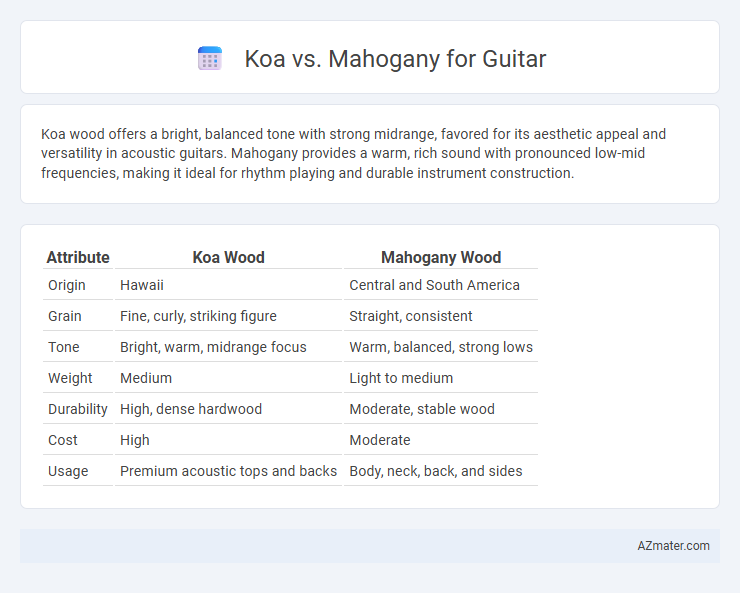Koa wood offers a bright, balanced tone with strong midrange, favored for its aesthetic appeal and versatility in acoustic guitars. Mahogany provides a warm, rich sound with pronounced low-mid frequencies, making it ideal for rhythm playing and durable instrument construction.
Table of Comparison
| Attribute | Koa Wood | Mahogany Wood |
|---|---|---|
| Origin | Hawaii | Central and South America |
| Grain | Fine, curly, striking figure | Straight, consistent |
| Tone | Bright, warm, midrange focus | Warm, balanced, strong lows |
| Weight | Medium | Light to medium |
| Durability | High, dense hardwood | Moderate, stable wood |
| Cost | High | Moderate |
| Usage | Premium acoustic tops and backs | Body, neck, back, and sides |
Introduction to Koa and Mahogany Woods
Koa and mahogany are two popular tonewoods widely used in guitar construction, each offering distinctive sonic and aesthetic qualities. Koa, native to Hawaii, is prized for its bright, crisp sound with a balanced midrange and visually striking grain patterns that develop a rich patina over time. Mahogany, commonly sourced from Central and South America, provides warm, resonant tones with strong mids and excellent sustain, making it a favorite for both acoustic and electric guitars.
Origin and Characteristics of Koa Wood
Koa wood, native to Hawaii, is prized for its rich tonal warmth and dynamic midrange, making it ideal for acoustic guitars. It combines the brightness of maple with the warmth of mahogany, offering a balanced sound with clear articulation and natural compression. Its visually striking grain and golden to reddish-brown hues enhance the aesthetic appeal of high-end guitars, contributing to both tonal complexity and unique appearance.
Origin and Characteristics of Mahogany Wood
Mahogany wood, primarily sourced from Central and South America, is known for its rich, warm tonal qualities and excellent resonance, making it a popular choice for guitar bodies. This hardwood features a dense, tight grain that contributes to its durability and distinctive reddish-brown color, which deepens over time with exposure to light. Mahogany's balance of strength and tonal warmth provides guitars with enhanced midrange clarity and a smooth, well-rounded sound profile favored in many acoustic and electric models.
Tonal Qualities: Koa vs Mahogany
Koa guitars deliver a bright and balanced tone with a strong midrange presence, combining warmth and clarity that suits fingerstyle and folk genres. Mahogany offers a richer, warmer sound characterized by pronounced lows and smooth mids, enhancing blues and rock styles with its resonant depth. The tonal qualities of Koa emphasize articulation and sparkle, while Mahogany provides a thicker, earthier sound profile favored by players seeking warmth and sustain.
Visual Aesthetics and Grain Patterns
Koa wood exhibits a striking visual aesthetic with rich, warm hues ranging from golden brown to reddish tones, featuring highly figured grain patterns such as curly, wavy, and tiger stripes that create dynamic, shimmering effects on guitar bodies. Mahogany presents a more uniform appearance with deep reddish-brown color and straight, fine grain patterns that emphasize elegance and subtlety, often lending guitars a classic, vintage look. The choice between koa and mahogany impacts the guitar's visual character, with koa offering bold, eye-catching patterns and mahogany providing a smooth, refined grain texture.
Durability and Workability in Guitar Construction
Koa and mahogany both offer excellent durability for guitar construction, with mahogany prized for its strength and resistance to impact, making it ideal for long-lasting instruments. Koa, while slightly softer than mahogany, is still durable and prized for its stable workability, allowing luthiers to easily shape and carve intricate designs. Mahogany's dense grain provides consistent stability, whereas koa's moderate hardness contributes to a balanced combination of ease in crafting and reliable endurance.
Suitability for Acoustic vs Electric Guitars
Koa wood, prized for its bright, balanced tone and visual appeal, is highly suitable for acoustic guitars, enhancing resonance and providing a crisp midrange that complements fingerpicking styles. Mahogany, with its dense grain and warm, rich tonal qualities, is favored for electric guitars due to its strong sustain and smooth low-end response, making it ideal for rock and blues genres. Acoustic guitars benefit from koa's vibrant clarity and visual grain patterns, while electric guitars leverage mahogany's depth and durability for solid body construction.
Price and Availability Comparison
Koa guitars typically carry a higher price tag than mahogany models due to the wood's rarity and distinctive grain patterns, making them more costly for manufacturers and consumers alike. Mahogany is more widely available and sustainably sourced, resulting in generally lower prices and greater accessibility for guitar builders and buyers. While koa offers premium aesthetics and tonal brightness, its limited supply often leads to longer wait times and higher costs compared to the more common and affordable mahogany.
Popular Guitar Brands and Models Using Koa and Mahogany
Famous guitar brands like Taylor and PRS prominently feature koa wood in models such as the Taylor K24ce and PRS Koa Custom 24, prized for its bright tone and striking grain. Mahogany is extensively used by Gibson and Martin in iconic models like the Gibson Les Paul Standard and Martin D-28, known for warm resonance and strong midrange presence. These woods influence the sound character; koa offers clarity and articulation while mahogany provides depth and richness, shaping the signature tones favored by professional musicians.
Choosing the Right Wood for Your Playing Style
Koa guitars offer a balanced tone with bright highs and warm midranges, ideal for players seeking a versatile sound that excels in both strumming and fingerstyle. Mahogany delivers a richer, darker tone with pronounced midrange and strong bass response, perfect for blues, rock, and rhythm-focused playing. Selecting between Koa and Mahogany depends on your tonal preference and playing style, with Koa suiting dynamic, expressive genres and Mahogany enhancing depth and sustain in more soulful or aggressive performances.

Infographic: Koa vs Mahogany for Guitar
 azmater.com
azmater.com